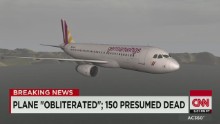Germanwings plane crash in French Alps: First clues
A quick descent. No distress call. The pilot's actions.It will be months, or longer, before the causes behind Tuesday's crash of Germanwings Flight 4U 9525 are known, but there are initial clues that aviation experts say will be the most important to investigators.Speculation comes in the wake of any tragedy such as this, but experts say certain facts can be significant for those who want to know what happened.
The most useful clues so far:
One of 'black boxes' found
One of the plane's "black boxes" has been recovered, the French interior minister said. It wasn't immediately clear whether it was the flight data recorder of the cockpit voice recorder, but it is a good sign that one of them was found just hours after the crash.
The cockpit voice recorder is designed to capture all sounds on a plane's flight deck, including conversations between the pilots. The flight data recorder stores a vast array of parameters about what the aircraft was doing, including air speed, engine performance and cabin pressure.
France's aviation accident investigation bureau will examine the device that was found immediately, the interior minister said.
Speed and path of descent
According to the airline, the flight had reached its cruising altitude of 38,000 feet at 10:45 a.m., then descended for eight minutes. The plane lost contact with French radar at 10:53 a.m. at a height of about 6,000 feet.
The speed and path of descent will be key data investigators use to determine what happened.
But the rate of descent isn't clear based on the data currently available, said Richard Quest, who covers aviation for CNN.
"Was this a controlled, gradual descent by the pilot? Or was there a manual descent where the plane was out of control? We don't know at this point," Quest said.
The timing of the crash
The data on air traffic accidents are clear: A majority of accidents happen upon takeoff or landing.
According to the Federal Aviation Administration, even though 83% of a plane's flight time is taken up with the climb, cruise and descent phases, less than 16% of accidents happen during this period.
CNN aviation analyst David Soucie described the timing of the crash as an "anomalous thing that happened."
It is "incredibly rare to happen in the middle of the flight," he said, meaning the pilot would have to act fast.
No distress call?
Contrary to some early reports, the French Civil Aviation Authority told CNN that the crew of the Germanwings plane did not issue a distress call.
It was air traffic controllers who sent out a distress call after radio contact with the plane was lost.

Germanwings did not issue distress call in plane crash 01:27
PLAY VIDEO
The lack of an emergency call can raise a red flag to a nonpilot. Why would a pilot not alert someone that there is an emergency? Does it hint to an incursion in the cockpit or a pilot's motives?
It might sound counterintuitive, but calling for help is not the first thing on a pilot's checklist when things go wrong.
Soucie said the principle that a pilot follows during an emergency is this: Aviate, navigate and communicate.
In other words, before turning on a distress call or transponder, the pilot's first concern is to fly the plane, and secondly, to find the safest option for a crash landing, if it comes to that.
The Germanwings pilot "was definitely aviating and navigating from what we can tell," Soucie said. The pilot was conceivably looking for a place to try to land, he said.
Germanwings crash in France
Departure: Barcelona, Spain, at 10:01 a.m. (26 minutes late)
Destination: Scheduled to land in Dusseldorf, Germany, at 11:39 a.m.
Passengers: 150 (144 passengers, six crew members)
Airplane: Airbus A320 (twin-jet)
Airline: Germanwings (budget airline owned by Lufthansa)
Flight distance: 726 miles
Last known tracking data: 10:38 a.m.
Last known speed: 480 mph
Last known altitude: 11,400 feet
Last known location: Near Digne-les-Bains, France, in the Alps
Sources: CNN and flightaware.com
A distress call -- had it happened -- could have signaled a different story.
CNN aviation analyst Mary Schiavo explained that there are codes that pilots have -- certain words that if uttered by the pilot indicate to air traffic controllers that there is a hijacking. The initial reports are that there was no hijack code transmitted from the plane. A big part of determining the cause of the crash will be whether such a code was sent or not.
"I don't think you'd rule anything out at this point," CNN aviation analyst Miles O'Brien said. "It's not like it appears as if it was an in-flight breakup. So what was going on in the cockpit is what we're going to be talking about in the coming days."
O'Brien pointed out the known details of the crash -- a rapid descent, no radio call and a flight that continues into the mountains -- are not part of a "typical emergency scenario."
Can't rule out weather
There were no reported weather issues during the plane's flight, but that does not mean you can rule these out as a possible cause, pilot and CNN aviation analyst Les Abend said.One thing Abend was looking at was a cold front progressing in the area where the plane was. It indicated some precipitation at lower altitudes.
So there may not have been bad weather at the cruising altitude, but "at lower altitudes, as they were beginning the descent, their visibility may have been obscured," Abend said.Reduced visibility in and of itself is not a huge issue, but the weather may have deteriorated as the plane descended and be a possible factor in the crash, he said.
News Courtesy: www.cnn.com











